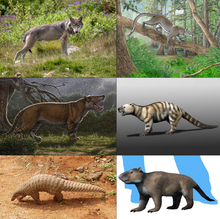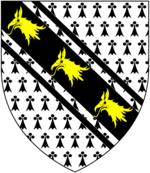페레
Ferae| 페레 범위: S P K N | |
|---|---|
 | |
| 과학적 분류 | |
| 왕국: | 애니멀리아 |
| 문: | 챠다타 |
| 클래스: | 젖꼭지 |
| 그랜드 오더: | 페룬구라타 |
| Mirorder: | 페레 린네, 1758년[1] |
| 서브그룹 | |
| 동의어 | |
페레(Ferae, / ff andri// FEER-ee, 라틴어: [ɛf̯rae], "야생동물")는 판카르니보라와 풀리도타몰파(Polidotamorpha)를 함께 뭉치는 태반 포유류의 보고이다.페라는 범은굴라타 군락의 자매 집단으로, 함께 그랜드 오더 페룬굴라타를 만듭니다.
분류 및 계통발생
종래의 분류
개정구분
현존 분류군의 계통 발생
판골린의 위치
팡골린은 다계통군인 에덴타타(Edentata)와 형성되는 크나스라(Armadillos, 개미핥기, 나무늘보)의 가장 가까운 친척으로 오랫동안 여겨졌다.면역 확산[9] 기술에 기초한 연구와 단백질과 DNA[10][11][12] 배열의 비교는 판골린과 육식동물 사이의 밀접한 관계를 밝혀냈다.살아있는 판골린과 육식동물들은 또한 골화된 소뇌 천막과 [13]손목의 척추뼈와 달 모양의 뼈의 융합과 같은 특이한 형태학적, 해부학적 특징을 공유합니다.현존하는 페라의 마지막 공통 조상은 약 7890만년 [14]전에 다양화된 것으로 추정된다.
페레 자매단
최근의 연구 (아래 그림에 반영)에 따르면, 페라의 가장 가까운 살아있는 친척은 미라목 은굴라타(Perissodactyla와 Artiodactyla를 [15][16]포함하는 포유류의 그룹)의 일원입니다.
또 다른 계통발생학에서는 페라에 가장 가까운 근연종은 아티오닥타일라가 [17]아닌 페리소닥타일라와 키롭테라(박쥐)라고 한다.페레와 페리소닥틸라는 주아마타라고 불리고 있다.페레, 페리소닥틸라, 치롭테라는 함께 페가소페레라고 불리고 있다.후속 분자 연구는 일반적으로 그 [18][19][20][21][22]제안을 뒷받침하지 못했다.
| 미르더[23][24][25][26][27] 페레 내 계통 발생 | |||||||||||||||||||||||||||||||||
| |||||||||||||||||||||||||||||||||
| 분지도는 화석 기록뿐만 아니라 미토콘드리아와 핵 DNA와 단백질 특성으로부터 재구성되었다. |
화석 부재
크레오돈타의 위치
페라에 크레오돈타 목의 포함에 대한 강력한 지지가 있었지만, 그들은 보통 카르니보라의 [4]자매 분류군으로 회복되었다.크레오돈트와 육식동물들이 공유하는 진단 특성에는 육식 치아의 [28]존재가 포함된다.Halliday et al. (2015) 고생세 태반의 수백 가지 형태학적 특성에 대한 계통발생학적 분석 결과 크레오돈트는 Pholidotamorpha(판골린과 그 줄기-친족)[29]의 자매 그룹일 수 있다.그러나 최근 연구에 따르면 Creodonta는 다계통성 분류군에 해당하지 않는다.이 그룹의 구성원은 카르니보라모르파(카르니보란과 그 줄기 친척)의 자매 분류군으로, 두 그룹으로 나뉜다. 한쪽은 옥시아노돈타 목, [30][6][7][8][31]다른 한쪽은 하이에노돈타 목과 그 줄기 친척(알타크레오두스와 티네르호돈)이다.
| 페레 [30][6][7][8][31]내 "크레오돈타"의 계통학적 위치. | |||||||||||||||||||||||||||||||||||||||||||||||||||||||||||||||||||||||||
|
대체 분류 및 가능한 구성원
Holiday 등(2015년)에서는 판토돈타, 태니오돈타, 디델포돈타과, 닉티데리아과, 옥시클라에나과, 팔레오릭타과, 펜타코돈타과와 같이 다양한 수수께끼의 팔레오렌세 포유류가 페레에 가능한 구성원으로 제안되었다.또한 중조류 및 아크토사이오노이드(일반적으로 줄기-아티오닥틸로[32] 간주됨)와 같은 다양한 "발굽 포유동물"도 이 그룹에 속합니다.또한 중농어류는 육식어류의 자매군으로서 중농어류는 육식어류 및 육식어류의 자매군으로서, 아크토시온 및 록솔로푸스 자매와 판토돈류 및 주변어류, 고니아코돈 및 어코노돈 자매와 함께 다계통하며, 대부분의 팔식어류 및 기타 근친어류와 관련된다.이 확대된 페라는 최근의 연구들이 이 [26][27]분류를 무시하지만,[29] 또한 키롭테라의 자매군인 것으로 밝혀졌다.
아래는 할리데이 외 연구진(2015년)[29] 이후의 다양한 현존 및 화석 그룹 간의 Ferae 내 상호 관계의 계통이다.
| ... |
| |||||||||||||||||||||||||||||||||||||||||||||||||||||||||||||||||||||||||||||||||||||||||||||||||||||||||||||||||||||||||||||||||||||||||||||||||||||||||
「 」를 참조해 주세요.
레퍼런스
- ^ "'Ferae' - The Linnean Collections". linnean-online.org. Retrieved 26 February 2020.
- ^ Zagorodniuk, I. (2008)"포유류 목의 학명: 서술적인 것부터 균일한 것까지" 생물 시리즈, Lviviv 대학의 Visnyk, Is. 48. 페이지 33-43.
- ^ a b Amrine-Madsen, H.; Koepfli, K. P.; Wayne, R. K.; Springer, M. S. (2003). "A new phylogenetic marker, apolipoprotein B, provides compelling evidence for eutherian relationships". Molecular Phylogenetics and Evolution. 28 (2): 225–240. doi:10.1016/S1055-7903(03)00118-0. PMID 12878460.
- ^ a b McKenna, M. C. (1975). "Toward a phylogenetic classification of the Mammalia". In Luckett, W. P.; Szalay, F. S. (eds.). Phylogeny of the Primates. New York: Plenum. pp. 21–46.
- ^ 말콤 C.맥케나, 수잔 K벨: 포유류의 분류: 뉴욕 컬럼비아 대학 출판부의 종 수준 이상(1997), 631 세이튼.페레
- ^ a b c Solé, Floréal; Ladevèze, Sandrine (2017). "Evolution of the hypercarnivorous dentition in mammals (Metatheria,Eutheria) and its bearing on the development of tribosphenic molars". Evolution & Development. 19 (2): 56–68. doi:10.1111/ede.12219. PMID 28181377. S2CID 46774007.
- ^ a b c Prevosti, F.J. 및 Forasiepi, A.M. (2018년)"소개. 신생대 남미 포유류 포식자의 진화: 고생물 지리학과 고생환경적 우발상황"
- ^ a b c Matthew R. Borths; Nancy J. Stevens (2019). "Simbakubwa kutokaafrika, gen. et sp. nov. (Hyainailourinae, Hyaenodonta, 'Creodonta,' Mammalia), a gigantic carnivore from the earliest Miocene of Kenya". Journal of Vertebrate Paleontology. 39 (1): e1570222. doi:10.1080/02724634.2019.1570222. S2CID 145972918.
- ^ Shoshani, J. (1 May 1986). "Mammalian phylogeny: comparison of morphological and molecular results". Molecular Biology and Evolution. 3 (3): 222–242. doi:10.1093/oxfordjournals.molbev.a040389. ISSN 0737-4038. PMID 3127652.
- ^ Shoshani, Jeheskel; Goodman, Morris; Czelusniak, John; Braunitzer, Gerhard (1985). Luckett, W. Patrick; Hartenberger, Jean-Louis (eds.). "A Phylogeny of Rodentia and Other Eutherian Orders: Parsimony Analysis Utilizing Amino Acid Sequences of Alpha and Beta Hemoglobin Chains". Evolutionary Relationships Among Rodents. NATO Advanced Science Institutes (ASI) Series. Boston, MA: Springer US: 191–210. doi:10.1007/978-1-4899-0539-0_7. ISBN 978-1-4899-0539-0.
- ^ Madsen, Ole; Scally, Mark; Douady, Christophe J.; Kao, Diana J.; DeBry, Ronald W.; Adkins, Ronald; Amrine, Heather M.; Stanhope, Michael J.; de Jong, Wilfried W.; Springer, Mark S. (2001). "Parallel adaptive radiations in two major clades of placental mammals". Nature. 409 (6820): 610–614. Bibcode:2001Natur.409..610M. doi:10.1038/35054544. ISSN 1476-4687. PMID 11214318. S2CID 4398233.
- ^ Murphy WJ, Eizirik E, et al. (14 December 2001). "Resolution of the Early Placental Mammal Radiation Using Bayesian Phylogenetics". Science. 294 (5550): 2348–2351. Bibcode:2001Sci...294.2348M. doi:10.1126/science.1067179. PMID 11743200. S2CID 34367609.
- ^ Gaudin, Timothy J.; Gaubert, Philippe; Billet, Guillaume; Hautier, Lionel; Ferreira-Cardoso, Sérgio; Wible, John R. (1 January 2020), Challender, Daniel W. S.; Nash, Helen C.; Waterman, Carly (eds.), "Chapter 1 - Evolution and morphology", Pangolins, Biodiversity of World: Conservation from Genes to Landscapes, Academic Press, pp. 5–23, doi:10.1016/b978-0-12-815507-3.00001-0, ISBN 978-0-12-815507-3, S2CID 214085088, retrieved 26 February 2020
- ^ Gaubert, Philippe; Antunes, Agostinho; Meng, Hao; Miao, Lin; Peigné, Stéphane; Justy, Fabienne; Njiokou, Flobert; Dufour, Sylvain; Danquah, Emmanuel; Alahakoon, Jayanthi; Verheyen, Erik (11 May 2018). "The Complete Phylogeny of Pangolins: Scaling Up Resources for the Molecular Tracing of the Most Trafficked Mammals on Earth". Journal of Heredity. 109 (4): 347–359. doi:10.1093/jhered/esx097. ISSN 0022-1503. PMID 29140441. S2CID 13614575.
- ^ Beck, Robin MD; Bininda-Emonds, Olaf RP; Cardillo, Marcel; Liu, Fu-Guo; Purvis, Andy (13 November 2006). "A higher-level MRP supertree of placental mammals". BMC Evolutionary Biology. 6 (1): 93. doi:10.1186/1471-2148-6-93. PMC 1654192. PMID 17101039.
- ^ Zhou, X.; et al. (2011). "Phylogenomic analysis resolves the interordinal relationships and rapid diversification of the Laurasiatherian mammals". Systematic Biology. 61 (1): 150–64. doi:10.1093/sysbio/syr089. PMC 3243735. PMID 21900649. (어드밴스 액세스, 2011년 9월 7일 온라인 공개)
- ^ Nishihara, H.; Hasegawa, M; Okada, N (2006). "Pegasoferae, an unexpected mammalian clade revealed by tracking ancient retroposon insertions". Proceedings of the National Academy of Sciences. 103 (26): 9929–34. Bibcode:2006PNAS..103.9929N. doi:10.1073/pnas.0603797103. PMC 1479866. PMID 16785431.
- ^ Matthee, Conrad A.; Eick, Geeta; Willows-Munro, Sandi; Montgelard, Claudine; Pardini, Amanda T.; Robinson, Terence J. (2007). "Indel evolution of mammalian introns and the utility of non-coding nuclear markers in eutherian phylogenetics". Molecular Phylogenetics and Evolution. 42 (3): 827–837. doi:10.1016/j.ympev.2006.10.002. PMID 17101283.
- ^ Springer, M.S.; Burk-Herrick, A.; Meredith, R.; Eizirik, E.; Teeling, E.; O'Brien, S.J.; Murphy, W.J. (2007). "The adequacy of morphology for reconstructing the early history of placental mammals". Systematic Biology. 56 (4): 673–684. doi:10.1080/10635150701491149. PMID 17661234.
- ^ Kitazoe, Yasuhiro; Kishino, Hirohisa; Waddell, Peter J.; Nakajima, Noriaki; Okabayashi, Takahisa; Watabe, Teruaki; Okuhara, Yoshiyasu (2007). Hahn, Matthew (ed.). "Robust Time Estimation Reconciles Views of the Antiquity of Placental Mammals". PLOS ONE. 2 (4): e384. Bibcode:2007PLoSO...2..384K. doi:10.1371/journal.pone.0000384. PMC 1849890. PMID 17440620.
- ^ Zhou, Xuming; Xu, Shixia; Xu, Junxiao; Chen, Bingyao; Zhou, Kaiya; Yang, Guang (2011). "Phylogenomic Analysis Resolves the Interordinal Relationships and Rapid Diversification of the Laurasiatherian Mammals". Systematic Biology. 61 (1): 150–164. doi:10.1093/sysbio/syr089. PMC 3243735. PMID 21900649.
- ^ Tsagkogeorga, G; Parker, J; Stupka, E; Cotton, JA; Rossiter, SJ (2013). "Phylogenomic analyses elucidate the evolutionary relationships of bats (Chiroptera)". Current Biology. 23 (22): 2262–2267. doi:10.1016/j.cub.2013.09.014. PMID 24184098. S2CID 9133016.
- ^ O'Leary, M.A., Bloch JI, Flynn, J. J., Gaudin, T. J., Giannini, N. P., Goldber, S. L., Kraatz, B. P. J., Z.-x.S., Rougier, G. W., Sargis, E. J., Silcox, M. T., Simmons, N. B., Spaulding, M. Velazco, P. M., Wekler, M. Wible, J. R. Cirane A.과학 339:6120:662-667.
- ^ Burger, Benjamin J. (15 October 2015). The Systematic Position of the Saber-Toothed and Horned Giants of the Eocene: The Uintatheres (Order Dinocerata) (PDF). Society of Vertebrate Paleontology 75th Annual Meeting. Dallas. Retrieved 20 February 2020. 컨퍼런스 요약(p.99) 2019년 12월 24일 웨이백 머신에 보관.설명과 결론: 17화: YouTube에서의 Uintates의 체계적인 위치(Order Dinocerata)
- ^ Orliac, M. J.; o'Leary, M. A. (2016). "The inner ear of Protungulatum (Pan-Euungulata, Mammalia)". Journal of Mammalian Evolution. 23 (4): 337–352. doi:10.1007/s10914-016-9327-z. S2CID 33676627.
- ^ a b Frank Zachos (2020) "맘말리아 계통학: 최근의 진보에 대한 간략한 개요, 저서: "유럽의 인간들 - 과거, 현재, 미래" (pp.31-48)
- ^ a b 설악, 징양호, 이원호, 이톈리, 둥밍서, 올리버A.라이더, 데이비드 M.어윈, 리유(2021년)"다양한 계통학 데이터셋은 로라시아테리어 간 관계의 일치 시나리오를 밝혀낸다", 분자 계통학 및 진화, 제157권
- ^ Floréal Solé & Tierry Smith (2013년) "고세-에오세 경계 부근 태반 육식 포유동물(Carnivorpha, Oxyaenodonta, Hyaenodontida)의 분포: 기후적이고 거의 전 세계적인 이야기" Geologica Belgica 16/4: 254-261.
- ^ a b c d e Halliday, Thomas J. D.; Upchurch, Paul; Goswami, Anjali (2015). "Resolving the relationships of Paleocene placental mammals" (PDF). Biological Reviews. 92 (1): 521–550. doi:10.1111/brv.12242. ISSN 1464-7931. PMC 6849585. PMID 28075073.
- ^ a b Borths, Matthew R; Stevens, Nancy J (2017). "Deciduous dentition and dental eruption of Hyainailouroidea (Hyaenodonta, "Creodonta," Placentalia, Mammalia)". Palaeontologia Electronica. 20 (3): 55A. doi:10.26879/776.
- ^ a b Floréal Solé; Bernard Marandat; Fabrice Lihoreau (2020). "The hyaenodonts (Mammalia) from the French locality of Aumelas (Hérault), with possible new representatives from the late Ypresian". Geodiversitas. 42 (13): 185–214. doi:10.5252/geodiversitas2020v42a13. S2CID 219585388.
- ^ Smith, De Bast (2013). "Reassessment of the Small 'Arctocyonid' Prolatidens waudruae from the Early Paleocene of Belgium, and Its Phylogenetic Relationships with Ungulate-Like Mammals". Journal of Vertebrate Paleontology. 33 (4): 964–976. doi:10.1080/02724634.2013.747531. S2CID 86402154.


